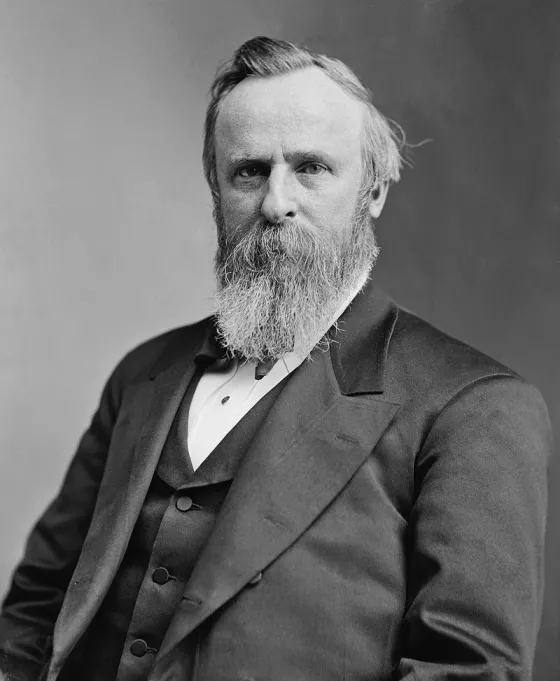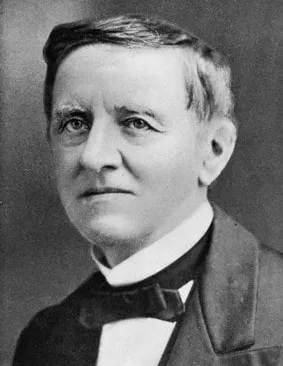
"A truce – not a compromise, but a chance for high-toned gentlemen to retire gracefully from their very civil declarations of war." By Thomas Nast in Harper's Weekly, February 27, 1877.
On November 7, 1876, eligible voters cast ballots for a new President of the United States. However, the winner of the election was not decided until March 1877 and with political wrangling and the Compromise of 1877. This election and its results as seen as the end of Reconstruction in the Southern states and placed another Union Civil War veteran in the White House.
Approaching the 1876 presidential election, some advisors suggested that incumbent president, Ulysses S. Grant, should seek a third term. He had strong popularity despite economic challenges and administration scandals, but Grant chose to follow George Washington’s precedent and only serve for two terms. (The 22nd Amendment to the U.S. Constitution was ratified in 1951 and now limits a president to two terms or a total of ten years.) Grant’s announcement that he would not run for re-election opened opportunity in the Republican Party.
The looming issues that the political parties and candidates faced included fixing government corruption, recovery from the Panic of 1873 and ongoing Reconstruction in Southern states in the aftermath of the American Civil War. After a contentious convention, the Republican Party nominated Rutherford B. Hayes to run for president as a compromise candidate within the party. The Democratic Party nominated Samuel J. Tilden. Three smaller political parties also put forward candidates for the presidential election; the Greenback Party sent Peter Cooper, the Prohibition Party nominated Green Clay Smith and the American National Party convinced James G. Walker.

Rutherford B. Hayes had served as a officer during the Civil War, eventually promoting to brevet major general and fighting at South Mountain and Cedar Creek. A lawyer by profession Hayes actually won an election to represent Ohio in the U.S. House of Representatives in 1864, taking his seat only after the conclusion of the Civil War in 1865. He also served as the 29th and 32nd Governor of Ohio. Politically, Hayes supported Reconstruction Era measures that ensured the civil rights of African Americans as promised in the 13th, 14th and 15th Amendments to the U.S. Constitution. Hayes’s military service allowed Republicans to “wave the bloody shirt” and tie political issues to Civil War sentiment; though Hayes was not well known outside of Ohio, he had popularity in his home state which was a swing state.

Samuel J. Tilden—the Democratic Party nominee—had grown up in New York and become interested in politics while working for former president Martin Van Buren. A lawyer and state assemblyman, Tilden had a long history of supporting campaigns of the Democratic party. He opposed slavery and during the Civil War eventually became a War Democrat and supported Lincoln’s re-election in 1864. Following the Civil War, Tilden served as chairman of the New York State Democratic Committee and then Governor of New York from 1875-1876. The Democratic Party platform promised to create an efficient government and reform the Reconstruction.
The Greenback Party—a short lived political party in the 1870s and 1880s—advocated for agricultural interests and wanted the federal government to allow or even encourage economic inflation by mass issuing paper money or “greenbacks.” Their candidate—Peter Cooper—was a New York City philanthropist and inventory. He had built an early steam locomotive and established the Cooper Union for the Advancement of Science and Art.
The Prohibition Party pushed for the elimination of alcoholic beverages for sale or consumption. Part of the Temperance Movement, this party encouraged direct election of senators, low tariffs, universal suffrage and welcomed immigration. Candidate Green Clay Smith had served as a Kentucky state representative prior to the Civil War, then fought as a Union officer and achieved the rank of major by the end of the war. He was elected to Congress during the war years and was sometimes in Washington D.C. and sometimes with the troops. From 1866 to 1869, Smith was the territorial governor of Montana. When he returned east, he became a minister and an advocate of the temperance movement.
The American National Party sometimes had different names in various states. Politically it advocated for the abolition of the Electoral College, Prohibition and a variety of social and religious controls for daily life. Candidate James B. Walker hailed from Illinois and his background was not well known, causing some newspapers during the campaign to question him and the platform he represented.
During the 1876 campaign season, both Hayes and Tilden (the major candidates) represented that they would support civil service reform and both major parties turned to mudslinging. Like previous elections, Hayes and Tilden did not actively campaign for themselves, relying on others to explain and rally their supporters. In the Southern states, militant groups practiced intimidation and voter suppression, trying to prevent African Americans and Republicans from voting.
Election Day gathered the votes but did not present an immediate winner. Election violence, accusations of fraud, disputes over electors and a close race contributed to no clear outcome. Supporters of candidates claimed their preferred man had won while the candidates themselves urged patience and President Grant reinforced the available military troops near Washington D.C. When it was time to count electoral votes, congressional Democrats objected to the process. If the election had to be decided by the House of Representatives and the solid Democratic majority rejected the votes of just one state, Tilden would be the winner. Instead, Congress passed legislation at the end of January 1877 to create an Electoral Commission which would have 15 members who would decide the election’s outcome. The commission’s members had different political backgrounds and were supposed to be impartial.
The Electoral Commission took on the disputed state elections from Florida, Louisiana, Oregon and South Carolina. After weeks of listening and debating, the commission gave the disputed 20 electoral votes to Rutherford B. Hayes. They did not make their final decision until March 2, 1877. Hayes now had 185 electoral votes to Tilden’s 184. However, Tilden had won the popular vote with 50.92%. The candidates from the other parties received no electoral votes and each has less than 1% of the popular vote. Hayes publicly took his oath of office on March 5, 1877. Tilden accepted the result, commenting that he would retire knowing he had won the popular vote but without having to take the responsibilities of office.
The commission’s decisions became known as the Compromise of 1877 with the conditions that United States troops carrying out Reconstruction and protecting civil rights would be withdrawn from the southern states…in return for the 20 electoral votes that secured Hayes’s election victory. The Compromise had other give-and-takes but is most significantly remember for ending Reconstruction. This disputed election also led Congress to pass the Electoral Count Act in 1887 which gave clearer rules for electoral vote counts.





